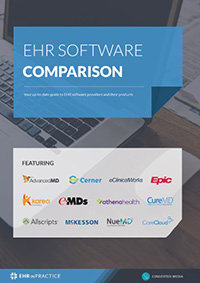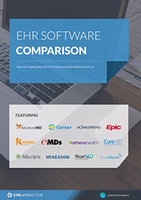EHR vs EMR: What’s the difference?
EHR and EMR are commonly used acronyms that are sometimes incorrectly used interchangeably. EHR stands for electronic health records and EMR stands for electronic medical records.
The EMR is the actual record, while the EHR is made up of so much more. Technically, the EMR came before the EHR, as the first electronic records were truly medical records, designed to be used within a medical practice. As healthcare systems and technology has evolved, EHR has become a much more commonly used acronym.
EHR vs EMR: Electronic Medical Records
Electronic medical records are the digital form of the paper charts that were used in the past. An electronic medical record contains the past medical history, medications, visit summaries, demographic and insurance information etc.
GET EHR RESEARCH & KNOWLEDGE RIGHT TO YOUR INBOX
Covering the key issues faced by businesses selecting and implementing EHR.
The EMR is contained within a medical practice setting, and works well for operations within the practice. However, electronic medical records do not have the capability to travel outside the practice easily. Typically, the record would need to be printed out to leave the office. When the information needs to be shared outside the practice, it is almost as if you are using paper charts.
EHR vs EMR: Electronic Health Records
Electronic health records do much more than the electronic medical record. The EHR provides agile information that can be shared across practices and specialties, connecting information from all facets of the patient care. EHRs are designed to be accessible by all professionals involved in a patient’s care, from the physicians, to nurses, to laboratories and even the patients themselves.
The sharing of information is done in a secure way, ensuring patient privacy and confidentiality. The secure sharing of a patient’s information allows for enhanced communication and healthcare coordination, allowing for a more comprehensive approach to healthcare.
Guide: EHR software comparison - side-by-side comparison matrix
For example, if a physician orders a complete blood count for his patient, the order is sent electronically to the laboratory. Then, the laboratory completes the lab workup, and is able to electronically input and share this information with the physician in real time. The physician is able to access this information and make an appropriate medical decision quickly.
EHR vs EMR: Why EHR?
The benefits of using an EHR system, and not simply an EMR, lie in the operations and efficiency of coordination of care and service delivery. The EHR safely and effectively stores health information and data, analyzes outcomes, allows for electronic prescribing and electronic communications, provides patient support, and increases the quality of administrative operations.
The EHR system also give the patient a greater role in their own healthcare management. The patient can access his/her own medical information, contact their healthcare provider and track their health history. Hopefully, this will lead to a more health conscious population living healthier lifestyles.
Free white paper

EHR Software Comparison
A hand-picked comparison of leading EHR software systems

Featured white papers
Related articles
-

5 key stakeholders in your EHR selection
Learn about the individuals that, when consulted early and often, can make your EHR selection pro...
-

5 important areas of EHR training during implementation
Successful EHR implementation is not possible without crucial EHR training
-

Top oncology EHRs to kickstart your selection shortlist
Learn about some of the leading oncology EHR systems on the market including CureMD, ARIA Oncolog...




